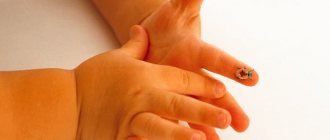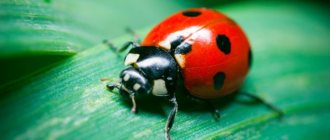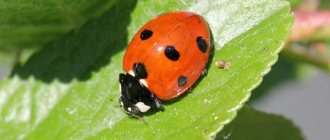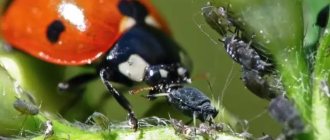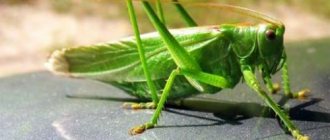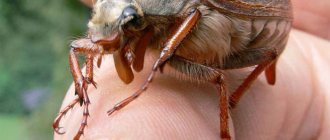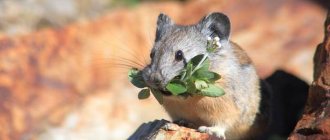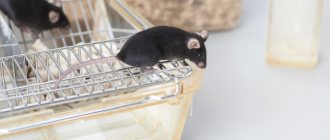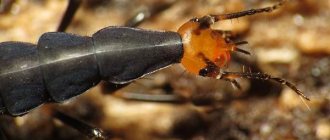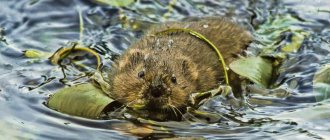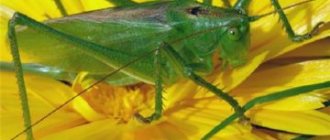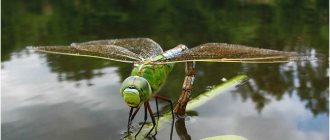Ladybug (lat. Coccinellidae) belongs to the family of beetles, a type of arthropod, a class of insects. When a person sees an insect, he involuntarily has a reaction - to slam it as quickly as possible, but the ladybug evokes sympathy in almost everyone, even women. Some remember a children's song associated with her, others remember that she really helps them out at their summer cottage - saving the garden from pests. What is the secret of everyone's sympathy for this beetle? In some cultures it is forbidden to kill a ladybug, and in the Western part it is generally considered a symbol of good luck. In many countries it is even included in the Red Book. Let's consider the characteristics and lifestyle of this insect, as well as the benefits and harms it can bring.
Ladybug protection
Photo: Ladybug from the Red Book
Ladybug has long been listed in the Red Book of many countries, including Russia. Its complete disappearance threatens to disrupt the balance in nature and actively multiply pests, which will then have to be destroyed with chemicals, and this in turn will further destroy the balance - a vicious circle is obtained.
It is likely that in the near future people will completely abandon the use of chemicals and turn for help to ladybugs, which from time immemorial have lived next to people and helped them in the struggle for the harvest. It is not for nothing that since ancient times people have praised and worshiped this tiny bug.
Nowadays, the ladybug is successfully bred under artificial conditions. Then they are sent to the fields, but, according to many experts, it is enough just to create favorable conditions for these bugs and their population will recover on its own without human help and will remain at the level required by nature. It is necessary to maintain a balance, and for this, first of all, you should abandon the use of chemicals to treat crops against aphids, and also direct your efforts to reduce the overall level of environmental pollution.
Tags:
- Coleopterida
- Panarthropoda
- ladybugs
- Bilaterally symmetrical
- Ancient animals
- Coleoptera
- Animals of Asia
- Animals of the Antarctic Belt
- Animals of Germany
- Animals of Eurasia
- Animals of Europe
- Animals of the Red Book
- Animals of the Red Book of Russia
- Animals of the forest
- Animals of the forest-steppe
- Meadow animals
- Animals starting with the letter B
- Animals starting with the letter K
- Animals of the fields
- Animals of Russia
- Animals of the steppe
- Animals of the Subarctic Zone
- Animals of the Subtropical Zone of the Northern Hemisphere
- Animals of the Subtropical Zone of the Southern Hemisphere
- Animals of the Subequatorial Belt of the Northern Hemisphere
- Animals of the Subequatorial Belt of the Southern Hemisphere
- Animals of the Tropical Zone of the Northern Hemisphere
- Animals of the Tropical Zone of the Southern Hemisphere
- Animals of the Temperate Zone of the Northern Hemisphere
- Animals of the Temperate Zone of the Southern Hemisphere
- Animals of Switzerland
- Animals of the Equatorial Belt
- Animals of South America
- Winged insects
- Cucuyiformes
- Cucuyoides
- Shedding
- Insects of the Red Book
- Insects of the Red Book of Russia
- Insects with complete metamorphosis
- Unusual animals
- New-winged insects
- Protostomes
- Herbivorous beetles
- The most beautiful animals
- The smallest animals
- Tracheal breathing
- Arthropods
- Hexapods
- Eukaryotes
- Eumetazoans
Bright warning coloration of a ladybug
The ladybug is endowed with bright colors, which help in the struggle for existence and strike fear into enemies, most often birds. This is one example of mimicry, like the green color of grasshoppers, or the ability of a chameleon to blend into its environment for the purpose of self-preservation.
The striking colors of the natural wild world serve as warning signals about the toxicity and inedibility of the observed prey. There is a theory that the brighter the color of the beetle, the less likely it is to be attacked by enemies. The expressive color of various types of ladybug indicates mortal danger. It may fade with age.
What does a ladybug eat?
Photo: Miraculous ladybug
The ladybug is a real predator among insects. Thanks to the structure of its jaw and the functioning of its digestive tract, it is able to hunt other insects and then quickly digest them. There are varieties that choose plant food: pollen, mold, flowers and leaves.
The diet of predatory species includes mainly:
- aphids in huge quantities;
- spider mites;
- caterpillars;
- insect larvae;
- butterfly eggs;
- some do not even disdain the larvae of Colorado beetles.
Ladybugs eat a lot, they are always hungry, especially their larvae. Each individual can easily destroy more than a hundred aphid larvae per day. Having large eyes, insects mainly use only their acute sense of smell in search of food.
The bugs do not hunt their victims, but only slowly, leisurely move through the foliage in search of food, and when they find a colony of aphids or a clutch of eggs of pests, they linger for a long time in this place for a meal until they destroy it completely. That is why the ladybug is a welcome guest on any personal plot, agricultural fields with crops, and in the garden. They are even specially bred at special enterprises and then distributed over cultivated lands with the help of agricultural aviation. Unfortunately, some varieties of these bugs, mainly living in Asia, cause damage to crops.
Now you know what ladybugs eat. Let's see how to breed these beautiful insects.
Where does the name ladybug come from?
The ladybug received its unusual name due to its bright red color, which aroused the sympathy of people. So, for example, in Slovenia and the Czech Republic it was called the “sun” (Slunechko), in Germany and Switzerland it is known as the “Virgin Mary’s bug”, in Latin America it is called “St. Anthony’s cow”. What is the origin of the name “ladybug”, there are two versions in this regard, according to the first, it was called “ladybug” for its ability to secrete poisonous milk, which scares off potential predators; our ladybug received the prefix “ladybug” for its meek and peaceful disposition. According to another version, these insects became “God’s” due to their ability to destroy aphids, thereby helping to preserve the crop.
Character and lifestyle of the ladybug
Ethnologists have observed how ladybugs gather in flocks in spring or autumn and go on long journeys.
Thus, the beetles are poisoned to spend the winter and return back in the spring. Almost like migratory birds.
They are forced to make unsafe long-distance flights in search of food. Mowed fields or meadows deprive cows of food, and they look for other places where there are still a lot of aphids.
Ladybugs fly so high above the ground that they may not be visible to the naked eye.
Sometimes, due to a strong gust of wind, the beetles leave the distance and interrupt their flight, and in some cases, flying over the sea, they die without ever seeing the shore.
Some cows gather in large flocks at the edges of the forest and prepare for the winter. Under a thick layer of leaves, under the bark of old stumps, they will shelter from frost until late spring.
While in wintering areas, ladybugs begin to show little activity and even appear on the soil when the average daily temperature rises to 5 degrees Celsius.
When the temperature reaches 10 degrees, some of the beetles from the forest-steppe fly to winter seedlings, to favorite perennial grasses and to abandoned virgin lands.
Ladybug larvae - what do they look like?
Further development occurs over 4-7 days and has several stages. The larvae are oval in appearance. They look colorful due to yellow-orange spots that form a certain pattern. Body surface with bristles, peculiar outgrowths. Newborn ladybugs that feed on scale insects are covered with whitish, waxy threads. Everything grows in 2-4 weeks.
After this stage comes the moment of pupation. To move into it, the individual attaches the back of the body to the leaf plate and curls into a semi-bent position. At the end of the internal transformation, the skins peel off from the pupa, sliding like a stocking to the end of the abdomen. It does not lose its bright color with black and yellow specks. Next, from 7 to 10 days, an adult is formed.
Reproduction of beetles
Between the third and sixth months of existence, individuals reach sexual maturity. Their breeding begins in mid-April. At this point, they are gaining strength after hibernation or migration. A male can recognize a female by the special smell released during the mating season.
The eggs are laid by the female near the aphid colony. This is done specifically so that the offspring are provided with the necessary nutrition. The oval-shaped eggs are attached to the underside of the leaf. Their surface is wrinkled and painted white or yellowish. One clutch can contain up to 400 eggs. Unfortunately, at the end of the mating season, the females die.
Variegated larvae appear after a few weeks. They are flat or oval in shape, and the surface of their body is covered with finely structured hairs or bristles and marked with a pattern of white and orange spots. In the first days of life, the larvae feed on the shell of the egg from which they emerged, and a little later they begin to eat other insects, in particular aphids.
After the larval stage, which lasts from 4 to 7 weeks, the pupa is formed. It is attached to plant foliage by means of an exoskeleton. During this period, the laying of insect body parts is carried out. After 7 days, an imago appears, that is, an adult that is fully formed and ready for life.
Predatory beetles are quite voracious, and this is of unconditional benefit to people. They spread quickly on crops in gardens. They also inhabit cultivated trees in human gardens. There is evidence that the larva can destroy up to 50 individuals of harmful parasites per day, and adults eat twice as much. People have long noticed this feature and are specially breeding populations of beetles on farmland. This measure is considered effective for clearing plantations and fields of pests.
But there are also herbivorous species. They live in the tropics of southeast Asia. These types of ladybugs are known to cause significant damage to crops. In Russia there are several representatives of the family that attack tomatoes, potatoes and cucumbers. Certain species happily eat sugar beet shoots .
Types of ladybugs, names and photos
The large family of ladybirds includes more than 4,000 species, divided into 7 subfamilies, which include approximately 360 genera.
The most interesting varieties of ladybugs:
Two-spot ladybird (Adalia bipunctata)
A beetle with a body length of up to 5 mm, dark red elytra and two large black spots. The prothorax lacks an anterior carina. The pronotum is black and has a yellow lateral border.
Seven-spotted ladybird (Coccinella septempunctata)
The most common ladybug in Europe. The size of a ladybug reaches 7-8 mm. The elytra are colored red; they have one small white spot (at the base) and three large black spots. The seventh spot of the ladybug is located on the pronotum (scutellum).
Twelve-spotted ladybug (Coleomegilla maculata)
The insect is 6 mm long and has pink or red elytra with 6 spots on each of them.
Thirteen-spotted ladybird (Hippodamia tredecimpunctata)
The dimensions of the elongated body of adult individuals range from 4.5 to 7 mm. The elytra of the ladybug are colored red-brown. There are 13 spots on them, some of which merge with each other.
Fourteen-spotted ladybird (Propylea quatuordecimpunctata)
It has yellow or black elytra with black or yellow dots.
Seventeen-spotted ladybug (Tytthaspis sedecimpunctata)
The insect's body is 2.5-3.5 mm long. Usually its color is bright yellow, sometimes it can be darker. These beetles live in Europe.
Asian ladybug (Harmonia axyridis)
The beetle has a body length of up to 7 mm. Within the species there are two subspecies. One of them has yellow wing covers with black spots, both large and small. The prothorax is white with a dark pattern. The second subspecies is characterized by black coloration of the elytra, on which red-orange spots are clearly visible. The prothorax is black with light yellow spots. This type of ladybug has 19 spots.
Ladybug (Hippodamia variegata)
Body size up to 5.5 mm. The pronotum is black and has two yellow spots. On the yellow-red elytra, 6 dark spots of various shapes and 1 large spot near the scutellum are clearly visible. The edges of the black pronotum are framed by a yellow border.
Ladybug (Anatis ocellata)
Quite a large insect with a body length of up to 10 mm. The color of the head and pronotum of this species of ladybug is black with small yellow spots. The elytra are yellow or red, each of them has black spots surrounded by lighter rims.
Alfalfa twenty-four-spot ladybird (Subcoccinella vigintiquatuorpunctata)
Pest of agricultural crops. A small bug with a body length of no more than 4 mm in an adult. The entire body of the ladybug is colored red. The elytra and pronotum are strewn with 24 small black spots.
Spotless ladybug (Cynegetis impunctata)
A rather rare species of ladybugs, the red or brown body of which is covered with small and thin fibers. The dimensions of the imago do not exceed 4.5 mm. There are no characteristic points on its elytra and pronotum.
Ladybug of the genus Sospita
has several types and color variations.
Ladybug Halyzia sedecimguttata
The insect has an orange wing cover with 16 white dots. Lives in Europe and the British Isles.
Ladybug Anatis labiculata
The insect is white or light gray with 15 black dots.
There is also a blue ladybug - this is Halmus chalybeus
Its elytra have a blue sheen, and its length reaches 3-4 mm. This insect lives in Australia.
The main enemy of aphids is the ladybug, its stages of development
Last time I talked about aphids and showed a photo of them. Today's story is about the main enemy of aphids - the ladybug . Everyone is familiar with the appearance of this bright red beetle with black dots on its back, but not everyone knows what its larvae look like, which are no less important, and are sometimes destroyed due to some similarity with the larvae of the Colorado potato beetle. Today I will show you what a ladybug larva looks like, how it grows, molts, how it eats aphids, pupates, and what hatches from it. I will show different types of adult ladybird beetles: the seven-spot ladybird (lat. Coccinella septempunctata) and the two-spot ladybird (lat. Adalia bipunctata) and tell you how they differ.
The ladybug is perhaps the most widely known beetle. Every child knows him. And most people are quite happy with this common name for dozens of species of ladybugs, quite different in appearance, which make up an entire family of beetles with the Latin name Coccinellidae .
Ladybugs are small insects well known for their bright colors and lack of fear of humans. Most people are familiar with the seven-spotted ladybug , but the species diversity of these insects is enormous. There are 5,200 species of ladybugs in the world, classified into the family of the same name in the order Coleoptera. Thus, numerous species of beetles are relatives of ladybugs.
What does a seven-spotted ladybug look like?
Seven-spotted ladybug (Coccinella septempunctata L.) This almost round beetle with red elytra and black dots on them is affectionately called in Ukrainian villages - the sun. Indeed, the ubiquitous inhabitant of fields, meadows and gardens cannot but arouse sympathy. For many, it is associated with childhood memories; many have at least once held it in their hands and watched how, having climbed onto their finger, the bug spreads its wings and flies “to the sky.” But entomologists know very well that the peacefulness of this ladybug is just an appearance. In fact, this is a real predator. He is constantly in search of more and more new victims, which he greedily eats.
Her elytra are bright red with black spots. Everyone remembers this. 3 on each elytron and one common subscutellum - seven in total. Upon careful examination, we see two more whitish spots: they are located on the forehead. The body length of beetles can vary: from 5 to 8 mm. This does not mean that a small beetle is young and a large one is old. It’s just that in the first case, the larva from which the beetle was formed clearly did not finish eating, it was simply starving. And in the second, she ate her fill. So the result turned out different.
What does a two-spot ladybug look like?
The two-spot ladybird differs from it in appearance . Ladybug is very variable in color. Usually the elytra are red, each with one black spot. They can be completely black or black with 2-3 red spots on each elytra. The pronotum in light forms is yellow with an M-shaped black spot, in dark forms it is black with yellow or white sides. The legs and chest are black, sometimes brownish-black in light forms. The mouthparts and antennae are yellowish-brown. Body length 3.5-5.5 mm.
The species is very common in Russia. It is found in fields, gardens, parks, forest belts, and less often in forests. The beetles overwinter in the litter in the same places where they develop in the summer. Sometimes hibernating beetles are found in crevices in the bark of trees. They appear earlier than other types of ladybugs; already in the second half of March it can be found in an active state.
During the season, the two-spot ladybird undergoes a change in biotopes. In spring and early summer, it is found mainly in orchards, where it feeds on apple, peach and reed aphids, and also settles on other tree species. The species is very rare on herbaceous plants of this time. From mid-summer, when the number of aphids in gardens decreases, beetles disperse more or less evenly on grasses and trees in search of food. At this time they are found on cereals and other field crops.
How does a ladybug develop?
On the underside of the leaf, the female lays her orange eggs in clusters of up to fifty in each. Just one female can lay up to 600 eggs. After one to two weeks, agile black larvae with yellow spots, 2-3 mm in size, emerge from them. While still very young, they already show their predatory nature and attack all living things that they see around them. Naturally, during this period, the victims correspond to the size of the predator: usually these are aphid eggs or their newly born larvae.
A month later, having destroyed many aphids and reached a length of a whole centimeter, the larva immediately in the feeding zone turns into a black, motionless pupa. And after another week and a half, a bug emerges from the skin that is cracked along the back. Having rested a little and waited for his elytra to thoroughly harden and become stronger, he realizes that he is hungry and begins to search for food.
The photo shows the molting of a ladybug larva. She sheds the exuvium (old skin) and underneath it is a new skin of light gray color. Insects have an external exoskeleton and are forced to shed the old small one, growing a new large one as they grow.
Ladybugs try to lay eggs near clusters of victims (aphids). Thus, the larvae of ladybirds are provided with food from the first minutes of life, however, finding food for them is not difficult, since the larvae are mobile and run quickly. The larvae are small, with an elongated, segmented body; some species may have branched outgrowths. The color of the larvae is gray (less often yellow) with yellow or red dots. The larvae are as voracious as their parents and can even attack prey that is larger than them. Their development lasts from 2-4 weeks to 3 months, during which time each larva can eat up to 1000 aphids.
The larvae of the two-spot ladybird are campodia-shaped. The head is yellow, only its lateral parts are black. The thoracic segments are white with black scutes. Abdominal tergites are brownish with a small white spot in the middle of almost all segments. The median parascolia on the fourth abdominal segment, as well as the space between them, are orange. This feature is clearly expressed and characterizes the species well. The length of the fourth instar larvae is 5.2-8.2 mm.
What do ladybugs eat?
The vast majority of ladybugs are voracious predators and only a few species are herbivorous. Predatory ladybugs are extremely voracious and can eat up to hundreds of small insects per day - aphids, spider mites, scale insects, whiteflies, and they prey not only on adult individuals, but also eat their larvae and eggs. Occasionally, ladybugs can even attack butterfly caterpillars. The victims of ladybugs are inactive, so hunting for them comes down to simply eating the victim.
Enemies of ladybugs
Ladybugs themselves have few enemies. Of course, they get in the way of birds, but they have an effective means of defense. From the joint of the legs they secrete a pungent yellow liquid with an unpleasant taste, so birds and lizards more often spit out the caught bug than eat it.
In the photo, a ladybug larva with black spines and yellow spots is eating a winged aphid.
Ladybugs have been respected and loved by people since ancient times. Among all nations, these bugs were considered a symbol of goodness, prosperity, and gullibility. Interestingly, in 55 world languages there are 329 names for these insects, one way or another connected with the concept of God! These insects are called “ladybugs”, “lady sheep”, “lady cattle”, etc. The English name (literally translated "Virgin bird") refers to the Virgin Mary.
And this connection arose thanks to seven points on the back of the most common species - the seven-pointed ladybug. The British interpreted the red color of the ladybug as a reminder of the passion of Christ, and seven black dots were associated with the seven sorrows of the Mother of God. Ladybugs have been a favorite object of children's folklore, because they willingly land on hands and clothes, and are accessible to observation even by the smallest naturalists.
In the photo, a ladybug larva is examining a leaf for the presence of aphids. It would seem that here she is, green, sitting, but the ladybug larva is looking for something on the other side of the leaf.
And for good reason. There is no living space on the underside of the leaf because of the aphids that have attached themselves to the veins of the plant. A noble feast awaits the larva!
When the ladybug larva has grown sufficiently and stored nutrients, it is time to metamorphose. She once again sheds her skin, attaches herself to some leaf with the back of her body, and turns into a pupa. After some time, the familiar red beetle with black dots will hatch from it.
What are the benefits of ladybug?
Now these peaceful and beautiful beetles continue to serve people. Ladybugs are used on an industrial scale to control crop pests. Farmers all over the world are happy to see ladybugs in their green spaces; moreover, there is a practice of importing large quantities of these beetles to many countries as a natural regulator to control various types of aphids. Pest control is the main task of two-spot beetles, as it helps reduce the total number of affected plants.
There is an interesting story connected with the seven-spotted cow. Knowing about its amazing gluttony and the enormous benefits it brings by protecting plants from aphids, American entomologists decided to bring (as they say in such cases, introduce) it to North America. They rightly believed that if this species acclimatizes, that is, adapts to the American climate, begins to reproduce and spread independently, local farmers will receive an excellent free assistant in the fight against harmful insects. The cows were caught in the thousands in Europe, placed in special container boxes and sent to the USA. There they were released everywhere, believing that they themselves would choose the most suitable places of residence. This went on for many years. And all to no avail. It must be said that not every introduction of a beneficial insect, as well as other animals and plants, is easy. Sometimes all efforts end in failure, and the efforts are wasted. In other cases, acclimatization takes many years. But this is what finally happened to the seven-spotted ladybird.
Desperate American entomologists were already ready to abandon this idea, when one day a New York nature lover brought to the entomological museum a beetle he had caught that had never been seen on the American continent. Imagine the surprise of the specialists when in the “foundling” they discovered one whose introduction and acclimatization had taken years and a lot of money. When investigating the story of the capture of the beetle, it turned out that it was found near the main airfield of New York. We began to explore its surroundings and quickly discovered a huge number of these beetles. They settled well here and ate with appetite their exotic food—North American aphids. It turned out that a large batch of Christmas trees imported from Europe, which had become unusable during the long transportation, had somehow been dumped near the airfield. Most likely, the cows were accidentally brought in with them. In one of the European countries, they settled down for the winter in the midst of these pre-prepared fluffy Christmas trees. But instead of calmly waiting for the arrival of spring, we unexpectedly found ourselves overseas. Here they had no choice but to wake up in a warm climate ahead of schedule and begin feeding and reproducing.
Kinds
In the family of ladybugs, there are about 360 genera alone. But, as you might guess, there are much more species in their composition, namely more than 4000. All their members in nature are distinguished by their bright colors. And this is not at all accidental, because such an outfit was given to the insect by nature to scare away possible ill-wishers.
There are many different colors of ladybugs
True, depending on the type it can be very different. Exotic rare varieties of these creatures are full of brown and dark blue shades with the addition of white, red, yellow, and black patterns. But what is most familiar to us is still rich yellow, and more often even bright red insects with dark spots, a black front part and legs.
A distinctive feature of the outfit of most types of ladybugs are dots (spots). There can be from two to seventeen, in some cases even more, pieces. The ladybug family itself is divided into 7 subfamilies. And the most interesting of the varieties with some additions will be mentioned below.
The seven-spotted ladybug is the most common species in European territory. The size of its representatives is usually no more than 8 mm. Her bright red outfit, as the name suggests, is marked with seven black spots.
Its elytra are decorated with three large black markings and another one stands out on the front of the back. In addition, at the base of these creatures there are two small, symmetrically located, white spots.
Seven-spotted ladybug
Two-spot ladybug. The length of this tiny creature is only half a centimeter. Such insects live not only on the European continent, but also in North America.
In Latvia, these members of the animal kingdom have been officially declared national insects for almost three decades. Their colors are made up of dark red and black.
Asian ladybug. This species is usually divided into two subspecies, which are easily distinguished from each other purely externally by color. One of them is black with orange-red markings on the elytra and light yellow on the front.
There are 19 spots in total. The other has a yellow main background, decorated with small and large black dots.
The ladybug is changeable. The coloring of this small member of the family consists of yellow-red and black areas. The six black spots decorating the elytra are variable.
Some of them may merge or even be completely absent. These cows live in Europe, and for some time now they have been brought to America.
The spotless ladybug is a clear confirmation of the fact that not all species of insects described have spots. True, this variety is very rare. Her outfit can be brown or red. Thin and small villi cover the body of such cows.
Blue ladybug. This variety really has such an unusual shade of the elytra. These small insects, whose body length usually does not exceed 4 mm, are found on the Australian continent.
Blue ladybug is very rare
Pictured is an ocellated ladybug
Structural features
The sizes of these insects vary from four to ten millimeters. They have an elongated oval or round body with a strongly convex back. For those who do not know how ladybugs reproduce, it will be interesting that the surface of some species of these insects is covered with fine hairs.
The body of the beetles consists of a small head, pronotum, thorax, abdomen and wings with elytra. In addition, each individual has three pairs of legs. They use cantharidin as protection against predators. This poisonous, unpleasant-smelling yellow liquid repels birds and other potential enemies from insects.
Depending on the type of insect, its elytra can be brown, dark blue, black, bright yellow or deep red. Some of them have spots of different shades and configurations. Others have no patterns at all. And the seven-spotted ladybug is so named because it has seven spots on its back.
Characteristics of an insect
There is no consensus on the origin of the name. It is interesting that in different languages it means only good things, for example calf, sheep, sun, red-bearded grandfather. The body length of the cow varies from 4 mm to 1 cm. The body is elongated-oval or almost round in shape. The back is very convex, the abdomen is flattened. Hairs grow on the lower surface of the body, but not in all species. The body is divided into the following parts
:
- abdomen;
- chest, including 3 sections;
- head;
- pronotum;
- 6 legs;
- elytra;
- wings.
The structure of the pronotum is transverse; there is a notch in the anterior part. The head is motionless and small, the eyes are very large relative to the body, convex. Movable antennae consist of 8-10 segments. There are often spots on the anterior edge of the pronotum, as well as on the head. The type of coloration differs among different species, and there are also beetles with a monochromatic back.
The middle and front parts of the chest are extended across the body, and the back part is almost square. All the beetle's legs are of medium length and look proportional in relation to the body. Each limb consists of one hidden and three obvious segments. The adult moves at high speed, using blades of grass, leaves, soil and other surfaces as support. The abdomen is divided into 6 segments covered with hard semirings (sternites).
The hind wings are designed for flight, and the front wings, in the process of evolution, developed into elytra. Their task is to cover the main pair while the beetle crawls rather than flies. Beetles protect themselves from birds and small animals that feed on insects by releasing a poisonous liquid with a nasty, pungent odor. The bright color also makes larger insects, as well as birds, afraid to taste it. Color options
:
- dark purple;
- brown;
- bright burgundy;
- brown;
- dark orange and others.
What does a ladybug look like: description
The ladybug is a small insect, with a body size of 4-10, 11 mm. The spotted beetle belongs to the order Coleoptera. The body has an elongated, oval-like or roundish shape. If you look from above, the body is highly convex, from below it is flattened. On the surface of many species, hairs are clearly visible - barely noticeable pubescence.
Body structure:
- head;
- front back;
- chest (including 3 sections);
- abdomen;
- 3 pairs of legs;
- wings with hard elytra.
The front back of the beautiful beetle has a transverse structure, highly convex, and a notch is clearly visible on the front edge.
The small head of the spotted beetle is slightly extended forward and motionlessly aligned with the front chest. The eyes are large, not protruding, the antennae are very flexible, consisting of 8 segments.
The hind chest, in contrast to the front chest and middle chest, which are extended across the body, looks like a square.
The cute insect has 6 moderately long legs, each of which consists of 3 obvious and one hidden segment. The paws help the bug quickly pick up each blade of grass and crawl through the grass. The abdomen consists of 5-6 segments.
With the help of their hind wings, cute insects take flight. The front wings eventually degenerated into hard elytra. They serve as protection for the hind wings while the insect crawls through the grass.
Bugs of various colors secrete cantharidin (a dangerous poison), thereby protecting them from predators.
The protective covers of the bug can be painted black, yellowish, deep red, brownish or blue with black, red, yellowish or whitish spots. All points have different shapes. In many insects, the spots merge together, forming spreading patterns. Some insects do not have them at all. By the pattern you can understand and determine what gender the ladybug is.
The only enemy of insects is dinocampus. Even the brightly colored insect with spots and the hemolymph secreted by it cannot save the insect from obvious death. The fact is that dinocampus lay eggs precisely in the delicate bodies of ladybird pupae, sometimes even in adult individuals. While developing, individuals parasitize and kill their host.
According to scientists, birds do not pose a danger to insects, since they secrete a toxic substance that is dangerous to birds. The bright coloring signals that birds should not approach and scares them away.
Varieties, their names, descriptions and photos
Below is a description of what ladybugs are, a detailed description of the most interesting varieties; You will also be able to see their photos, including close-up photos.
Point-to-point
The body length of the two-spot ladybug reaches about 5 mm. The color is dark red with two parallel black dots on the back (hence the characteristic name). The body has an oblong-oval, moderately convex shape.
The head of light-colored individuals is black, with two large irregularly shaped spots (near the eyes). Dark bugs have a completely black head.
Seven-point
The seven-spotted ladybird is one of the most common species in Europe. The body size is about 8 mm. The color is red, and there are 3 black spots on the sides. The seventh spot is located near the head.
Twelve-point
The twelve-spotted ladybird reaches 6 mm in length. It has a red or pink color. There are 6 black dots on each elytra. The insect lives primarily in North America and feeds on pollen from agricultural plants.
Thirteen-point
The thirteen-spotted ladybird has 13 spots on its surface. Color - red-brown or brick. In this case, some spots may merge with each other. The insect is common in Europe, Asia and North America.
Asian
The Asian ladybird or Harlequin reaches a length of 7 mm. It is either yellow-black or black-orange in color. The insect lives in Asia and feeds on aphids.
Note! This species is characterized by the greatest gluttony, therefore it is specially cultivated in Europe and North America to combat agricultural pests.
Ocellated
The ocellated ladybug is considered one of the largest and reaches a length of approximately 1 cm. The color is red or yellow. In this case, each of the spots is surrounded by a lighter halo. There are 20 such “eyes” on the back of the insect.
Pointless
The spotless ladybird is one of the rarest species, characterized by a complete absence of dark spots. The body of the insect is red or brown in color and covered with barely noticeable fibers. The insect reaches several millimeters in length.
Blue
The blue cow is the most unusual representative of this family. A distinctive feature of the insect is the blue color of the elytra with a characteristic metallic sheen. Dark spots on the back are absent (or simply not visible, because they merge with the dark blue color).
It lives in the eastern part of Australia, as well as in New Zealand. The insect feeds mainly on aphids. The body size does not exceed 4 mm.
Features of character and lifestyle
Photo: Red ladybug
All varieties of ladybugs choose an isolated lifestyle and form groups only for flying to warm regions or wintering in a secluded place. These huge groups can number up to 40 million individuals. You can also notice clusters of bugs during their mating season. All these bugs do not hesitate to feast on the larvae of their relatives, but only in the absence of a sufficient number of aphids and other food. But there are varieties of ladybugs that purposefully destroy their fellow creatures.
These insects are active all day, they slowly crawl from one plant to another in search of food. Given enough food, the lifespan of some individuals can reach two years or even more, but this happens extremely rarely. The main part dies much earlier, before reaching the age of one year, and there are many reasons for this: from lack of nutrition to environmental pollution.
Reproduction
Discussing the topic “When and how a ladybug reproduces,” it is worth noting that this process occurs from the beginning of March, and one insect mating sometimes lasts up to 9 hours in a row. The female can lay from five to three hundred yellow eggs that have an elongated shape. For laying, she chooses places with a large concentration of aphids, since the number of offspring depends on this.
A week later, the eggs hatch into larvae with well-developed jaws. They are very voracious and eat huge amounts of aphids. The larvae themselves have a disgusting taste, so almost no one hunts them. After another ten to fifteen days, a ladybug pupa emerges from the larva, which attaches to the plant leaves using the remains of the exoskeleton. After another two weeks, during which all the characteristic parts of the body are formed, it turns into a fully formed adult.
A young insect can be recognized by its pale color and lack of pattern. Over time, the back of the ladybug acquires a rich shade, and a corresponding pattern appears on it. In general, the duration of the full cycle of development and transformation is from four to seven weeks.
Lifestyle and habitat
Of course, such creatures can fly; this is even stated in children’s rhymes. And they have two whole pairs of wings. True, only the rear ones are adapted for air movement, and the front ones, in the course of evolution, turned into rigid protective wing covers.
Nature has reliably protected this insect from the encroachments of ill-wishers. The ladybug is so bright that it can scare away predators. But it’s not just the overly conspicuous coloring that plays a role here.
A good defense against potential attackers is the special natural liquid secreted by such insects in anticipation of danger. This is what is commonly called cow's milk.
In case of danger, the ladybug secretes a specific liquid
It has an unpleasant odor, is poisonous, has a yellow tint, and contains cantharidin. This milk repels all insidious predators, even the formidable tarantulas. And almost no one in nature dares to touch the harmless ladybug.
However, there is still a parasitic insect from which such creatures have no protection. These are dinocampuses. They gradually kill the cows and their pupae by placing their eggs there, which destroy them as they develop.
The habitat of ladybugs depends on their variety. Some of them are perfectly adapted to live in meadows near rivers and streams; others can only exist in trees. There are known varieties that settle only on certain types of flora, for example, aquatic plants, reeds, sedges, field grasses; some look for places where aphids accumulate because they feed on them.
However, ladybugs of any species are not social and prefer for the most part an existence isolated from their relatives. But at certain times they break this rule. For example, during the breeding season or when they gather together for winter flights to areas of the planet where there is no cold.
In general, different types of ladybugs spend the cold season in their own way. Those of them that have adapted to life in temperate areas and are sedentary usually choose convenient shelters from winds and frosts: terraces, garages, barns, houses.
Sometimes, in search of shelter, they unite in groups, even large communities, the number of individuals in which amounts to tens of millions. In winter, they can hide in piles of leaves, bark and rocky debris.
Habitat
The ladybug lives in all climatic zones and on every continent except Antarctica. The beetle cannot survive only in places where the temperature remains below freezing all year round. For example, it is not high in the mountains, where there is snow all the time. Countries with the most species: Norway, Iceland, Sweden, Denmark, France, Poland, the Netherlands, Italy, Germany, Japan, Pakistan, Mongolia, India, Korea, China.
More often the insect settles on crops covered with aphids, but sometimes it chooses reeds, sedges and young reeds as a habitat. There are species that prefer to inhabit field plants. Some prefer the banks of reservoirs, others need a shady, but not waterlogged area.
Insects live separately for most of their lives. You can see many individuals together only during wintering, migration or mating season. Although the beetle tolerates cold, it is a heat-loving insect. In the warm season, it prefers climates of temperate latitudes, and during cold weather, some subspecies move to other countries. The life expectancy of such species reaches 2 years, and with a lack of nutrition - even less.
There are sedentary insects that gather in colonies of up to 40 million for the winter. One such community can weigh 2-3 tons. Having taken refuge from the cold and huddled together, insects survive severe frosts. During the winter, many die, but the main part of the colony emerges from hibernation in the spring. It is not difficult to find where ladybugs hibernate in the garden: they usually choose places between stones, plant debris, and foliage.
Types of ladybugs, photos and names
Zoologists identify 4,000 different species of ladybugs, divided into 7 subfamilies. We will describe the most interesting among them.
This is a beetle with a body length of up to 5 mm, with a dark red body and two black dots (hence the name).
Seven-spotted ladybird
It is this type of ladybug that is most common in Europe. Its size is 7-8 mm. Its elytra are painted red, there are three black spots on the sides, and the seventh is located near the head of the insect.
This ladybug has a length of 6 mm, a bright pink or red color, and, accordingly, 12 black spots on the elytra.
Thirteen-spotted ladybird
This type of ladybug has as many as 13 spots against the background of red-brown elytra; some of its spots can merge with each other.
Asian ladybug
This ladybird is up to 7 mm long and is divided into two subspecies. One of them has a yellow wing cover with black spots, both large and small. The second subspecies is characterized by black coloration of the elytra, on which red-orange spots are visible.
Ocellated ladybird
This is a very large representative of the ladybird family, reaching up to 10 mm in length. It has red or yellow elytra and black spots surrounded by lighter rims.
Pointless ladybug
This is a very rare species; its characteristic feature is the absence of signature spots. Also, the red or brown body of the pointless ladybug is covered with small fibers.
Blue ladybug
This is another unusual member of the ladybug family, having a characteristic blue color. Such insects live exclusively in Australia.
Origin of the species and description
Photo: Ladybug
The ladybug is a very common ancient arthropod insect all over the world, a representative of the order Coleoptera and the ladybird family. This insect received its scientific name Coccinellidae due to its scarlet color. The bug lives almost everywhere. It was popularly nicknamed the ladybug because of the poisonous white liquid or “milk” that the insect secretes to scare away predators, and the ladybug because it helped in the fight against aphids and other pests to preserve the harvest, had a gentle disposition, and did not cause any harm to humans. .
Video: Ladybug
In Germany and Switzerland, the tiny insect is called St. Mary's bug, in South America - St. Anthony's ladybug. There were many legends about this little bug; it was said to have the ability to influence the weather.
Interesting fact: Even in ancient times, the Slavs considered the ladybug to be a heavenly creature, a messenger of the sun. That is why she was often called “Sunny”. It was forbidden to drive away the insect, so as not to incur bad luck. A bright bug that flew into a home brought blessings.
There are a huge number of varieties of ladybugs: the entire family has more than four thousand species, which in turn are divided into 7 subfamilies and 360 genera. The ladybug differs from other representatives of the family Coccinellidae in the structure of its legs. In the structure of each of them there are three visible and one hidden segment, so they seem to be three-component.
